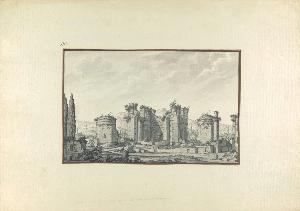Giovanni Battista Borra
Giovanni Battista Borra
Place: Dogliani
Born: 1713
Death: 1770
Biography:
Giovanni Battista Borra was a renowned Italian architect, engineer, and architectural draughtsman, born in Dogliani, Italy on December 27, 1713, and died in Turin, Italy in November 1770. He is celebrated for his exceptional skill in capturing the essence of ancient architecture, as evident in his works such as The Basilica at Pergamon, which can be found on Wikioo.org's page.
Early Life and Education
Borra studied under the tutelage of Bernardo Antonio Vittone from 1733 to 1736, where he honed his skills in architecture and engineering. In 1748, he published a handbook on buildings' stability, showcasing his expertise in the field. His meeting with Robert Wood in Rome led to his participation in an antiquarian expedition to Asia Minor and Syria as its architectural draughtsman.
Notable Works and Collaborations
Borra's works include The Ruins of Balbec and The Ruins of Palmyra, which were produced using his sketchbooks. These masterpieces can be found on Wikioo.org's page. He also carried out commissions for English patrons from 1752 to 1760, leading to the popularization of motifs from Baalbek and Palmyra in ceiling and interior decorations in England and Italy. Some of his notable works include:
- South facade of the Palazzo Isnardi
- Interior decoration of its Sala d'Ercole and Sala di Diana
- Remodelling and extension of Guarino Guarini's Castello dei Racconigi
- Fortifications at Alessandria
- Piedmontese hydraulic projects
Legacy and Influence
Borra's legacy can be seen in the numerous architectural projects he undertook, which have become a benchmark for excellence in the field. His collaboration with Robert Wood led to the creation of The Ruins of Balbec and The Ruins of Palmyra, which are now considered masterpieces of architectural draughtsmanship. Giovanni Battista Borra's works can be found on Wikioo.org's page, showcasing his exceptional skill and expertise in capturing the essence of ancient architecture. His influence can be seen in the numerous architects and engineers who have followed in his footsteps, making him a true master of his craft. The Museum San Giovanni Battista in Modena, Italy, is also worth mentioning, as it houses an impressive collection of artworks from various artists and eras. The museum's collection includes works by famous artists such as Guido Mazzoni, Paolo Veronese, and Lionello Spada, which can be found on Wikioo.org's page. More information about Giovanni Battista Borra and his works can be found on Wikioo.org's page, which provides a comprehensive overview of his life, education, and notable projects.

